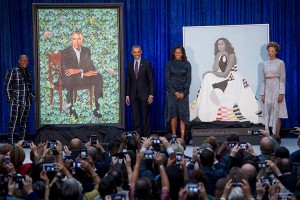Black History Month: Painter Kehinde Wiley

Former United States President Barack Obama and First Lady Michelle Obama (both center) pose next to their portraits at their unveiling at the Smithsonian’s National Portrait Gallery in Washington, D.C., in 2018. Barack’s portrait was painted by Kehinde Wiley (far left). Michelle’s was painted by Amy Sherald (far right).
Credit: © Saul Loeb, AFP/Getty Images
February is Black History Month, an annual observance of the achievements and culture of Black Americans. This month, Behind the Headlines will feature Black pioneers in a variety of areas.
Until recently, tracksuits, flatbill hats, jeans, Nike T-shirts, and puffer jackets did not appear in many portraits in museums. Now in the National Portrait Gallery and galleries across the world, American painter Kehinde Wiley has livened up modern-day portraits. Wiley is known for his large, highly detailed, brightly colored portraits. His style has been called urban Baroque, a reference to the Baroque art movement of the 1500′s and 1600′s. Baroque art is large in scale and filled with dramatic details.
In 2017, Wiley was selected to paint the presidential portrait of former United States President Barack Obama. Wiley became the first Black American artist to paint an official presidential portrait. Wiley’s portrait of Obama was unveiled in 2018. It hangs in the National Portrait Gallery in Washington, D.C.
Wiley was born on Feb. 28, 1977, in Los Angeles, California. He was interested in painting from a young age. Wiley received a Bachelor of Fine Arts degree from the San Francisco Art Institute in 1999. He received a Master of Fine Arts degree from Yale University in New Haven, Connecticut, in 2001.
Wiley served as artist-in-residence at the Studio Museum in Harlem in New York City from 2001 to 2002. It was in Harlem that Wiley developed his unique approach to portraiture. He approached strangers on the street, asking them to pose for him. He photographed the subjects in their street clothes and then painted them in a classical European style. He called this process “street casting.” Wiley continued this process in such places as Morocco, Haiti, and India. Wiley’s signature background depicts flowers and foliage or abstract shapes. The bright, detailed backgrounds are reminiscent of the Baroque style.


